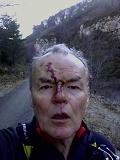Je cours (beaucoup) donc j’essuie (des plâtres). Autrement dit, courir c’est tomber. Puisque je cours environs 2.000 kilomètres par an, je tombe au moins deux ou trois fois dans l’année. Pas toujours des gros bobos. Des fois quand on ne fait que trébucher, c’est une peur qui réveille sur le coup et puis un soulagement et/ou embarras de se rendre compte que ce n’était rien.
L’embarras peut aussi frapper quand on chute bêtement devant autrui. Curieusement cela m’arrivait assez régulièrement en courant sur des chemins de randonnée toujours dans les mêmes circonstances. Je courais tranquillement seul, et puis au rencontre d’un groupe de randonneurs, paf ! Je me retrouvais sur les fesses. Vu du côté des autres cela a dû être assez marrant, voir un peu bizarre.
Ceci m’arrivait trop souvent pour être le hasard et je me suis rendu compte que c’était dû à un excès de politesse en quelque sort. Avant de dire « bonjour », j’ai tendance à vouloir établir « eye contact » c’est-à-dire de regarder les gens dans les yeux, plutôt de leur adresser la parole la tête baissée. Du coup, pendant un court laps de temps, je perdais vu d’où passaient mes pieds, et la chute se produisait. La morale de ceci est, ou bien de ne pas regarder vos interlocuteurs en montagne, ou bien de s’arrêter un moment pour mieux les saluer.
Ce type de chute se produisait toujours à la descente – souvent sur un sol un peu poussiéreux. En effet la géologie joue un rôle important dans les chutes. La roche peut être accrocheuse ou glissante selon sa composition et selon, bien évidemment, qu’elle est mouillée ou sèche. Mais si une roche lisse et mouillée incite à la prudence, la poussière est plus sournoise. En général, un chemin poussiéreux est plutôt sympa pour le coureur. Ca donne une surface qui n’est pas trop dur et en règle général, est assez accrocheur. Mais bien évidemment, il y a une limite (d’adhésion) à tout. La chute typique dans ces circonstances n’est pas trop grave mais cela surprend ! Soudainement on se retrouve sur les fesses, avec (encore) un brusque réveil. La gravité de cette chute est bien entendu accrue si les fesses rencontrent un objet peu commode – rocher anguleux, flaque d’eau ou bouse de vache.
Mais pour le vrai coureur de trail, les chutes ne se produisent pas en arrière mais par le devant. Ici il y a encore plusieurs configurations de chute avec ou sans gravité. Commençons par le « best case scenario ». On court sur le plat passablement vite quand soudain, on accroche sur une branche, pierre ou un objet métallique sortant de la terre. On plonge vers l’avant, les mains touchent par terre (mais pas trop), la tête baisse et on accomplit un tonneau – et on peut même, exceptionnellement, continuer dans son lancé pour se retrouver encore debout.
Bien entendu, le ‘best case’ ne se produit que rarement. Il y a maintes possibilités de tomber court … de l’idéal. Par exemple – on peut se faire très mal aux mains en devant s’appuyer trop. On peut rencontrer un obstacle, par exemple un rocher, sur une partie de l’anatomie, le coude, l’épaule, nécessitant une radio et immobilisation du bras pendant quelques jours. Les possibilités sont innombrables. Il m’est arrivé un bel accident il y a une semaine où j’ai eu l’occasion d’observer de très près un exemple de l’enchaînement d’événement lors d’une chute vers l’avant.
Je ne courais pas vite – je venais de mettre mon chien sur la laisse avant de traverser une ferme et je trottinais à moins de 8 km/h. Mais attention – 80 kg à 8 km/h et à plus d’un mètre du sol égal une certaine quantité d’énergie quand même. Donc j’ai trébuché. Initialement çà semblait sans gravité. Sur le coup je croyais pouvoir éviter la chute. Pendant quelques dixièmes de seconde donc, mes pieds accéléraient pour compenser la vitesse de mon haut du corps vers le devant. Dans ces circonstances, le haut du corps descendant, les jambes accélérant, une bataille d’inertie est engagée. Si le bas gagne, on est sauvé. Si le haut l’emporte on touche terre – malheureusement à une vitesse supérieure à l’initiale. De plus est, on tape par terre dans une très mauvaise posture. On va vite et on est trop allongé pour permettre un rouleau vers l’avant. On frappe le chaussé comme une crêpe – flan !
Ouch!
Voici ma photo d’un tel exploit – non pas la pire des chutes – rien de cassé si ce n’est pas les lunettes (explosés). Et sur le coup j’avais très mal à la tête. Mais en quelques minutes j’avais retrouvé mon esprit. J’étais curieux de savoir exactement ce qui m’a fait tomber et j’ai donc retracé mes pas jusqu’au point de départ de la chute. Rien de particulier si ce n’est que quelques gravillons. Le problème vraisemblablement était au niveau de mes chaussures « accrocheuses ». En effet, peut être un peu trop même, voila la bonne blague – avec sa chute !

